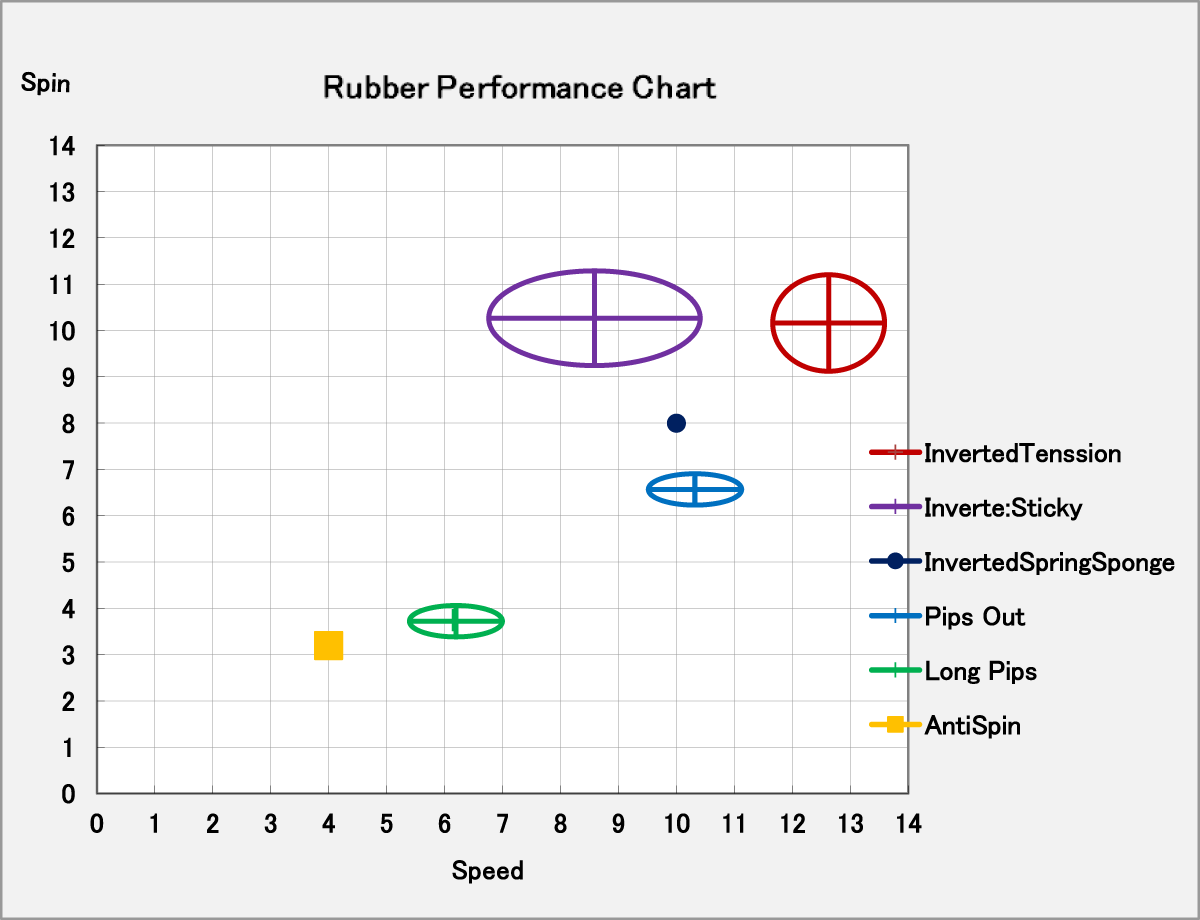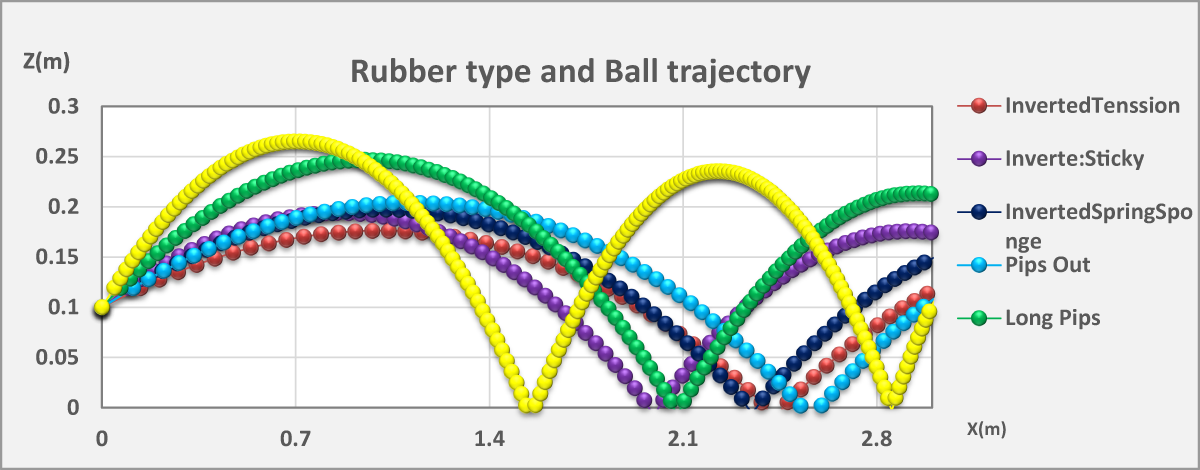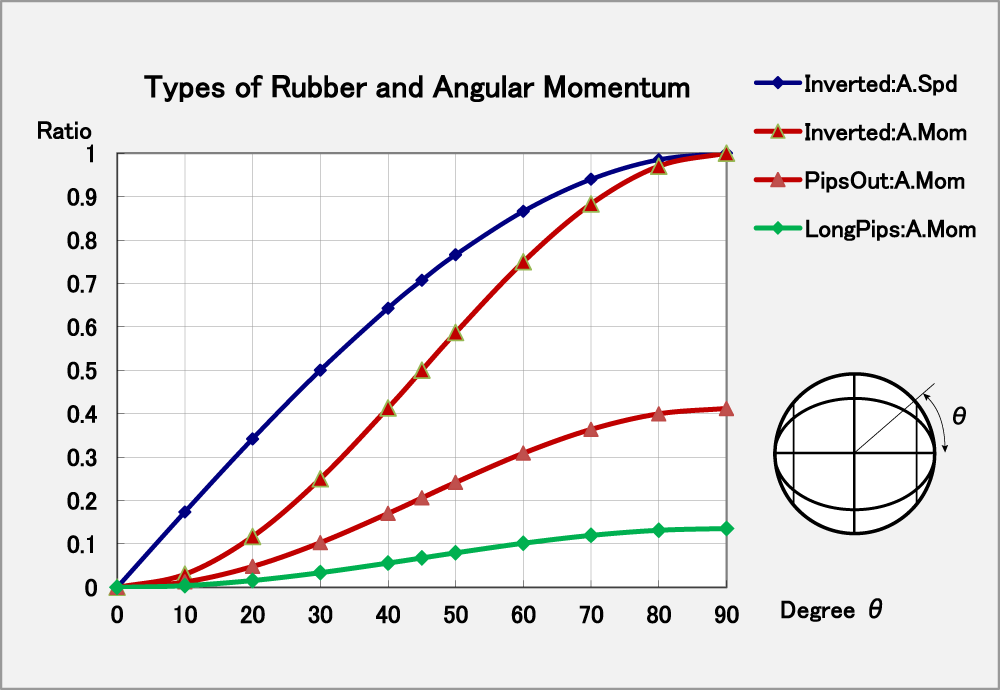Part 5. Tactics against Various Rubberers
5.1. Rubber Characteristic and Ball Trajectory
Although it is my subjectivity, roughly 60% of players wear the Inverted rubbers on both sides, 30% of players wear the Pips-out or Long-pips rubbers on both sides or one side, 10% of players wear the Pips-out and Long-pips rubbers on the only one side. If you have many chances to play against Inverted rubbers than another rubbers, you may think in this extension that your opponent is using the Inverted rubber even if the opponent is using another rubbers.
Here, we give an overview of basic tactics from the performance of rubber, the trajectory, and the angular momentum.
5.1.1. Performance position of various rubbers
See the following performance chart of various rubbers. Inverted-tensions, Inverted-stickies, Inverted-highly-elastics, Pips-outs, Long-pips, Anti-spins. These are placed in the chart. The center of the ellipses is the mean value and the ellipse sizes show the standard deviation.
Talk with average values to handle roughly. The performance of these rubbers are the average of the BUTTERFLY products.

5.1.2. Rubber type and ball trajectory
The figure shows the trajectory according to the rubber type when hitting at the same angle and with the same force based on the above performance position table.。

What you can see from this figure is that compared to Inverted tension
- Anti and one-sided rubber do not have a long flight distance. If you hit it normally, you won't cross the net.
Pips-out becomes a present ball with a high trajectory and no flight distance. In reality, the opponent will adjust the height beyond the net, so the flight distance will be shorter. - Pips-out becomes a present ball with a high trajectory and no flight distance. In reality, the opponent will adjust the height over the net, so the flight distance will be shorter.
- Since the Pips-out rubber has a large flight reaction force, it can be seen that the trajectory is low and the flight distance is long.
- Inverted-Sticky has a large upper spin and a small flight distance, but in reality, if the opponent's ball has a spin force, the repulsive force will increase the flight distance of the ball.
5.1.3. Various rubbers and angular momentum
The point to pay attention to here is friction. Recall that when a spinning ball hits a stopped racket, friction converts "rotational momentum" into "flying momentum."
Let's estimate the strength, angular momentum, and momentum of the spin that returns to you depending on the angle of the opponent's hit point with respect to the spin axis.
The following graph is drawn assuming that the angular momentum of each rubber is proportional to the coefficient of friction coefficient between each rubber and the Inverted rubber.

When you use the Inverted rubber to give 1.0 angular momentum to the equator of the ball,
When the opponent hits with a racket at an angle of 90° with the Inverted rubber, 1.0 is converted to jump and consumed and does not remain as a spin. 1At an angle of 45°, 0.5 angular momentum is converted to jump and consumed, and 0.5 remains as spin and returns.
When the opponent uses the Pips-out rubber, when hitting the racket at an angle of 90°, 0.65 is converted to jump and consumed, and 0.35 remains as a spin. At an angle of 45°, the angular momentum of 0.3 is converted into jump and consumed, and 0.7 remains as spin and returns.
When the opponent uses the Long-pips rubber, when hitting the racket at an angle of 90°, 0.65 is converted to jump and consumed, and 0.35 remains as a spin. At an angle of 45°, the angular momentum of 0.2 is converted into jump and consumed, and 0.8 remains as spin and returns.
5.1.4. Basic Tactics from the Characteristics of Rubber
(A) Basic tactics against Long-pips rubber
In a match where you are an Inverted Rubber and your opponent is a Long-pips Rubber
- Since Long-pips rubber has small flight and friction, the flight distance does not increase with receive, so if you send service to the opponent's middle with a knuckle, the probability of catching the ball on the net increases.
- The ball that the Long-pips rubber sends out with a serve has a small friction of about 1/3 of the inverted rubber, so the flight distance of the ball you hit is short and the probability of getting caught in the net is high. It is necessary to take about 1.5 times as much contact time as the Inverted rubber and return it.
- The spin sent by the Long-pips rubber by receiving is as small as about 1/3 of the inverted rubber, so more than 2/3 of the spin you sent will be kept as it is and will come back. It is necessary to make a strategy by relying on the spin of.
(B) Basic tactics against Pips-out rubber
In a match where you are an Inverted Rubber and your opponent is a Pips-out Rubber
- Since the Pips-out rubber has a large flight and small friction, the flight distance increases with receive, so if you send a service with fast lateral rotation deep to the back side, it will be difficult for the opponent to control the flight distance and the probability of table out will increase. It gets higher.
- The ball that the Pips-out rubber sends out with a serve has a small friction of about 2/3 of the inverted rubber, so the flight distance of the ball you hit is short and the probability of getting caught in the net is high. It is necessary to take about 1.3 times as much contact time as the Inverted rubber and return it.
- The spin sent by the Long-pips rubber by receiving is as small as about 1/3 of the inverted rubber, so more than 2/3 of the spin you sent will be kept as it is and will come back. It is necessary to make a strategy by relying on the spin of.
(C) Basic tactics against Inverted-Sticky rubber
In a match where you are an Inverted-Sticky Rubber and your opponent is a Inverted-Sticky Rubber
- Sticky rubber has a lot of friction, so the faster the spin you send, the greater the effect, so when your opponent blocks, the chances of the ball tableing out or getting caught in the net are high.
- When you receive a spin on Sticky rubber, add Hcork or Fcork to reduce the forward flight distance and tilt the angle in the flight direction to increase the distance to the end line and avoid table out.
- When you receive the backspin of the Sticky Rubber, tilt the front of the racket slightly upward so that the ball crosses the net and add Hcork or Fcork to prevent the ball from getting caught in the net.